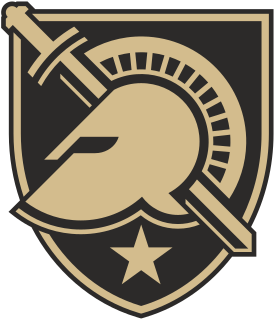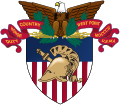"Hail to the Redskins" was the fight song of the Washington Redskins, an American football team belonging to the National Football League (NFL) and now known as the Washington Football Team. The song was performed after the team scored touchdowns from the 1938 season until 2019. The music was composed by the team's band leader, Barnee Breeskin, and the lyrics were written by Corinne Griffith, the wife of Washington founder and owner George Preston Marshall.
In U.S. and Canadian sports, a fight song is a song associated with a team. In both professional and amateur sports, fight songs are a popular way for fans to cheer for their team, and are also laden with history; in singing a fight song, fans feel part of a large, time-honored tradition. Although the term "fight song" is primarily used in the United States, the use of fight songs is commonplace around the world, but they may also be referred to as team anthems, team songs or games songs in other countries, even such as Australia, Mexico and New Zealand. Fight songs differ from stadium anthems, used for similar purposes, in that they are usually written specifically for the purposes of the team, whereas stadium anthems are not.

Cheering involves the uttering or making of sounds and may be used to encourage, excite to action, indicate approval, or welcome.
The University of Alabama is a school with many traditions. This article describes several of these traditions.

"The Victors" is the fight song of the University of Michigan (UM) written and composed by UM student Louis Elbel in 1898. The song was first played publicly by John Philip Sousa and his band.
"Victory March" is the fight song for the University of Notre Dame. The Rev. Michael J. Shea, a 1905 Notre Dame graduate and organist at St. Patrick's Cathedral in New York, wrote the music, and his brother, John F. Shea, who earned degrees from Notre Dame in 1906 and 1908, wrote the original lyrics. At the behest of his former music teacher, Professor William C. Hammond of Mount Holyoke College, Rev. Shea would first perform the song publicly on the organ of the Second Congregational Church of Holyoke, Massachusetts, where Hammond was music director, soon after completing the composition with his brother in the winter of 1908. The song would first be performed on Notre Dame's campus on Easter Sunday, 1909, in the rotunda of the Golden Dome. The lyrics were revised in the 1920s; Victory March first appeared under the copyright of the University of Notre Dame in 1928.

West Point Cemetery is a historic cemetery in the eastern United States, on the grounds of the U.S. Military Academy in West Point, New York. It overlooks the Hudson River, and served as a burial ground for Revolutionary War soldiers and early West Point inhabitants long before 1817, when it was officially designated as a military cemetery.
"Victory for MSU", formerly "MSU Fight Song", is the official fight song of Michigan State University, US. MSU's fight song was created in early 1915, when MSU was known as Michigan Agricultural College (M.A.C.). An MSU cheerleader, Francis Irving Lankey, along with lyricist Arthur Sayles, created the song. With several changes noted below, the school has used the same song ever since. The MSU Fight Song is played at all university sporting events and is frequently sung by students and alumni.
"Buckeye Battle Cry", composed by vaudeville performer and songwriter Frank Crumit, is one of two fight songs of the Ohio State Buckeyes. Every football game in Ohio Stadium begins with Ramp entrance by The Ohio State University Marching Band, performed to "Buckeye Battle Cry". The tradition of Script Ohio ends with the singing of one chorus of the fight song by band members. The song is also played after every Buckeye score.
Oskee Wow-Wow is the official fight song of the University of Illinois at Urbana-Champaign. The song was written in 1910 by two students: Harold Vater Hill '11 (1889–1917), credited with the music, and Howard Ruggles Green '12 (1890–1969), credited with the lyrics.

The Army Black Knights football team, previously known as the Army Cadets, represents the United States Military Academy in college football. Army is a Division I Football Bowl Subdivision (FBS) member of the NCAA. The Black Knights play home games in Michie Stadium with a capacity of 38,000 at West Point, New York. The Black Knights are coached by Jeff Monken who is entering his eighth in season as head coach. Army is a five-time national champion, winning the title in 1914, 1916, and from 1944 to 1946.

"There Goes Old Georgetown" is the unofficial name of the Georgetown University sports teams' fight song. It is also known as simply "Georgetown Fight Song". It is actually an amalgamation of three songs, only the oldest of which, 1913's "The Touchdown Song", contains the lyric "here goes old Georgetown". Onto a version of this was added "Cheer for Victory", written in 1915, and "The Hoya Song", written in 1930, both of which are included in their entirety. The authors of these songs, and of the combined version, are unknown. Although some effort has been taken to change the song, no serious proposal has come forth.
"Stand Up and Cheer" was written by Paul P. McNeely in 1909 for use at the University of Kansas, where it is still played today as a secondary fight song, and used as the primary fight song at Ohio University, Athens. It is also played as a secondary fight song at Columbia University.

The Army Black Knights are the athletic teams that represent the United States Military Academy, located in West Point, New York. In sports contexts, the teams are commonly referred to as Army West Point. The Black Knights compete at the National Collegiate Athletic Association (NCAA) Division I level as a non-football member of the Patriot League, a Division I Football Bowl Subdivision independent school and a member of Atlantic Hockey, the Collegiate Sprint Football League (men), the Eastern Intercollegiate Gymnastics League (men), the Eastern Intercollegiate Wrestling Association, the Great America Rifle Conference, the National Collegiate Boxing Association, the National Collegiate Paintball Association and the National Intercollegiate Women's Fencing Association. Army is also one of approximately 300 members of the Eastern College Athletic Conference (ECAC).

"Hail to Pitt" is the most traditional fight song of the University of Pittsburgh, which is commonly referred to as Pitt. The saying "Hail to Pitt!" is also the most traditional and commonly used slogan of the University of Pittsburgh and its athletics teams. The slogan is frequently used in promotional material, printed on merchandise and souvenirs. It was also the title of a 1982 history of Pitt athletics by author Jim O'Brien. The slogan is often used among alumni as a statement of affiliation, including as a closing signature in conversation or correspondence between alumni, and is sometime abbreviated as "HTP" or "H2P", the latter of which is a registered trademark of the university and is frequently used on official university signage and merchandise.
Come Join The Band is the official fight song of Stanford University. The lyrics were written in 1907 by screenwriter and playwright Aurania Rouverol, then a student at Stanford, and are set to the trio from Robert Browne Hall's New Colonial March. Although Come Join the Band remains Stanford's official fight song, the Stanford Band nowadays plays All Right Now as their usual fight song at football games.

The Catholic University of America's intercollegiate sports teams are called the Cardinals, and they compete in the NCAA's Division III. They are members of the Landmark Conference, the New England Women's and Men's Athletic Conference (football) and the Mid-Atlantic Rowing Conference (rowing). The team colors are red and black.
"Fight for LSU" is the official fight song of the LSU Tigers and Lady Tigers intercollegiate sports teams of Louisiana State University in Baton Rouge, Louisiana.

Philip Egner was a U.S. military bandmaster who served as longtime director of the U.S. Army's West Point Band.
The Minnesota State Rouser, also known as The Maverick Rouser is the fight song of the Minnesota State University, Mankato. It is played at all Minnesota State Mavericks athletics games, rallies and at many alumni events. The Maverick Machine, the Minnesota State University Marching Band, plays the rouser along with other popular songs and the song of the university, the Minnesota State University Hymn.









